By Jeffrey A. Rendall, Photos By Jeff Janas
ROANOKE, WV -- It's easy to get sensory overload these days. Face it, there's a lot to see, hear, taste, smell and touch -- and these sensations, when added to the everyday stimulations of caffeinated coffee and the stressful morning commute, can be overwhelming. Though it's impossible to completely shut them off, sometimes it'd be nice if the senses just gave us a break.
But it also seems, in order to excel, maybe all that's required is a little extra focus on what they're telling us.
That's what Randy Hernly, Head Golf Professional at Stonewall Resort (in central West Virginia), recommends: "It may sound simple, but I really believe that golf courses should, when you step onto the tee, focus your eyes on where you have to go. Here, a lot of folks have said 'you've got too much high grass,' but on this course, the high grass bordering the golf holes helps define the course. And that's the thing that I think is very clear out here -- the short green grass tells you what you need to do."
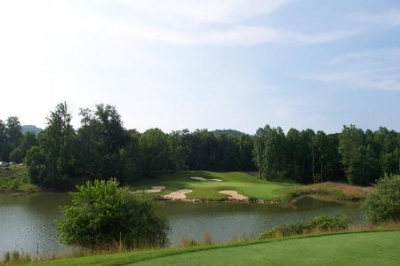 |
| Stonewall Resort's 6th is one of the most beautiful holes you'll see anywhere. |
Focus is certainly one of them. But another would be to enjoy yourself, and soak up the experience. That's a lot to require from a resort course, but Stonewall's certainly passed the test with flying colors. The Arnold Palmer designed golf course opened in June of 2002 and since that time, has drawn rave reviews for its scenic offerings, excellent course conditions and challenging play.
This golf course alone helps you understand why the West Virginia motto reads 'Wild and Wonderful,' because Stonewall Resort is both.
Erik Larsen, former Vice President at Palmer Course Designs (and the Project Architect at Stonewall), says the course is a little bit more wild, but just as wonderful as your typical Palmer course: "I'd say Stonewall's different than a lot of the courses we've designed in that it's more difficult -- but that's mainly because it's fairly tight. Most of our courses actually play easier than they look. We try to make 'em look pretty dramatic, yet you'll score just as well or better than you would on your home course."
Larsen continues, "But Stonewall's the other way around. It's a very subtle course visually, but it'll bite you playing it. I've said all along that this course is a little gem, mainly because of its scenery, but it's also going to play difficult. It's a gorgeous site with a ton of variety, but there was a very small amount of usable space -- which is unusual for a core golf course without real estate."
Just from the brief drive onto the property, you'll gather the undulating reality of the course. You'll see some holes down in a valley, but also what looks like a tee box and fairway up on a hill. Then, you're ascending another decent sized slope to reach the clubhouse area, and then down another gentle incline to the first tee. You just might need your Dramamine before you even hit your first shot.
Don't get me wrong -- everything is extremely well done, and as you'd expect from a Palmer designed course, fits the land like it was there from the beginning.
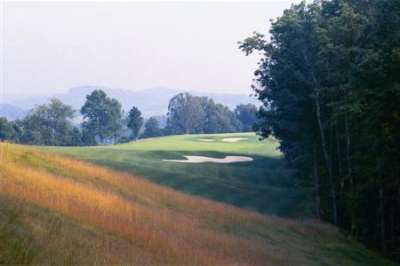 |
| No doubt, a contrast in colors up on the mountain. Here, looking towards the 15th fairway and green. |
Larsen says it was a bit of a routing adventure to finish the project: "It probably appears like there was a tremendous amount of usable space at Stonewall, but there really wasn't. We did a number of routing plans, trying to make the golf course fit the best it possibly could. The difficulty was... there were a couple different good potential clubhouse locations. So, with each different route, the clubhouse would move, so the course had to chase it around a bit."
"Usually, you start at the clubhouse and then put in holes one, nine, ten, eighteen and the driving range. But this course didn't work that way -- you had to use all the maximum space. There were several different valleys -- the main valley was two holes wide, and the little finger valleys were only one hole wide. And every once in a while, you had to find a place to play up top, like number ten (164 yard par three). You normally wouldn't use ground like that to put in a golf hole, but we found a pretty flat spot for the tee and green sites, so all in all it worked," Larsen remembered.
It did work. So well, in fact, that when you're playing the course, you're focusing on the playing areas and not really devoting attention to the fact it must've been quite an engineering and construction feat to just put in cart paths (especially on the back nine). The last thing you'll want when playing golf is to worry about whether your cart's going to cause your undoing. Here, you're not even aware of the possibility.
One thing that you are cognizant of, is the lack of development. Stonewall resides in a state park, and you'll certainly notice the lake that's the centerpiece for the resort offerings -- but you'll also grasp that there're no condos or cabins on the links themselves.
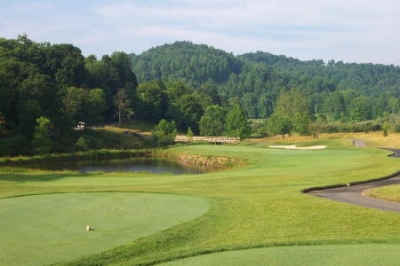 |
| Flat ground here on the par three 2nd hole, but you can tell from the background that you'll be in the hills at some point. |
Hernly says that's a unique feature, for this type of course. "I think one thing that's really unique about this course is that it's not in a real estate development. No houses, and you're out there all by yourself with nature -- and there never will be any houses. That's unusual these days, when they're even building houses around places like The Greenbrier."
The atmosphere is also somewhat apart from the previously referenced five-star resort, as Hernly expounds upon: "The environment, the isolation, just being out here -- you're just off the interstate for three miles, then all of a sudden, it's like 'here it is.' The lodge, the whole atmosphere that we try to create with that -- it's very casual, kind of rustic, almost secluded. Wherever you go, you can wear your blue jeans, or whatever feels comfortable (no jeans allowed for golf, of course)."
Comfort is a good thing. And you'll certainly feel that way out on the links, though it might not always be in the golf sense. As amply alluded to in the text above, the course isn't overly wide, and those high grass areas are waiting for golf balls struck more than a tad offline.
Even the second longest tees carry a 141 slope. That's some tough going.
Hernly says it's a matter of mind over heather. "You have to drive the ball well on this course, and you have to be able to not let the grassy border areas intimidate you. If you go from grass-line to grass-line, a lot of those areas are 50-60 yards wide, which is a pretty big area to hit a golf ball into."
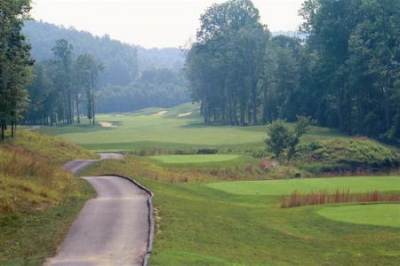 |
| Trouble short, left and right off the tee of the par five 7th, but there's still quite a large landing area in between. |
"But if you stand there, like on the third or fourth tee and see that tall grass, and think 'I can't go there' -- that can be a bit intimidating. You can't let those surrounding areas scare you or lull you to sleep. That's why I say, keep focusing on the short green grass," Hernly instructed.
He's probably referring to the potential problems from the farthest back set of tees (Palmer tees, 7149 yards, slope of 143), because as you'd presume on a Palmer course, there's always a less taxing alternative from where to play.
"We have six tee boxes on most holes -- that we use to set out five sets of tee markers, so you can play the course at virtually any length you want. I think it's friendly to the female or senior golfer, because it's a different course for them. It doesn't eliminate the hazards or high-grass areas, but the landing areas are wide and carries manageable from those tee boxes," Hernly said.
Hernly says you also might want to mix up your tee choices a bit: "There isn't a lot of difference in distances between the tee boxes on our par fives and threes. The par fours are where the real changes come. So, I tell people to think about mixing it up a bit -- play the par fives and threes from the gold tees, and the par fours from the blue tees, or the blues and whites, or however you want. I think that makes it more fun."
One other element of difficulty at Stonewall is the putting surfaces -- they're relatively small for a resort course, and just as undulating. "The smaller greens at Stonewall -- that's good and bad. Good that you're going to have a short putt when you're on them, but bad that they're harder to hit. They may seem a little more contoured than usual, but that's only because they're smaller," Larsen said.
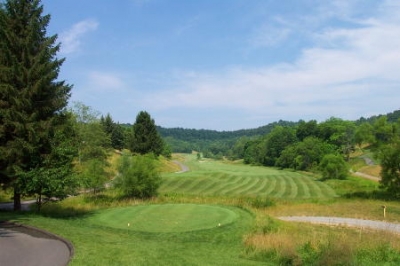 |
| Looking from the tee box of the 439 yard, par four 11th hole -- focus on the short green grass, and you'll be okay. |
Then Larsen gave the technical explanation of why they were built that way: "You still have to chase contour from the normal grade, or you end up cutting slopes or filling more than you want to." Huh?
"If there'd been more room to build them, it would've been easier to soften 'em up," Larsen added. That sounds more like it.
Whatever the explanation, Stonewall's course is a thrill-ride of contours, target shots, breathtaking scenery and non-stop challenge from the first through the eighteenth holes.
It's difficult to pick out highlight holes on a course like this, because there really isn't a single hole that isn't memorable. One that everyone will remember is number six, a 166 yard par three that plays over a finger in the lake. Rated the easiest hole on the front side, it plays slightly downhill and asks for only about a hundred yard carry over the water. Hitting the green doesn't end the work, however, as it's a very undulating putting surface.
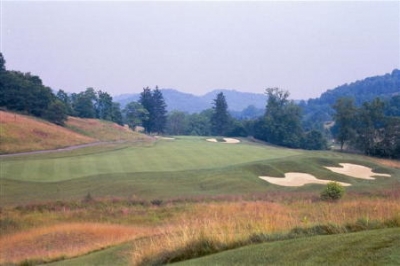 |
| From the Palmer tees, it's a huge carry to fly the bunkers on the right of the 13th hole, but average duffers shouldn't have a problem. |
Seven is a terrific, three-shot par five (580 yards) with a fairly wide tee ball landing area. Once there, however, you've really got to buckle down and choose your next option, because trees jut in from the left side to influence your second shot. Hernly says the best choice is to lay-up short of a bunker on that side, then hit a wedge onto the green for a potential birdie.
The back nine plays quite a bit more up-and-down, and requires an even higher degree of precise shot making. The seventeenth hole (455 yard par four) is one of those love it or hate it situations -- primarily because of a large, dead tree in the middle of the marsh area that separates fairway and green.
Larsen said there was some discussion on whether to leave the tree as is, or take it out: "We had a big argument on that one," he chuckled. "I said that to leave that tree where it is, makes the hole unfair, because even a good drive might end up behind it. Well, the owner said he wanted to leave it in, because it added character to the hole. So, we decided to bet on whether Arnold would say to leave it in, or take it out."
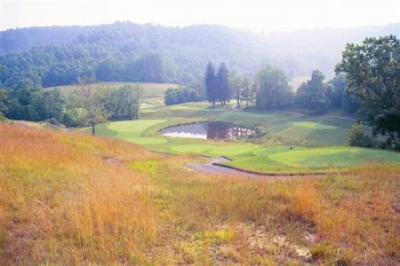 |
| The view from the 16th tee is spectacular... and intimidating. |
"Well, Arnold initially said 'Take it out'... and then the owner lobbied his case to leave the tree in -- that it added this and this and this to the hole. We'd agreed not to say anything about it, just to let Arnold decide. So I said 'That's a foul!' and refused to pay the bet," Larsen laughed.
The tree does add character, and is certainly yet another interesting aspect of Stonewall Resort's golf course. But using the tree as an example, you may not agree with everything you'll find there.
It's not likely, however, that you'll do anything but enjoy this terrific resort course. Stonewall is a challenging test, and though you may find yourself in some of that high grass on occasion (no matter how hard you concentrate on safety), you'll certainly have no problems focusing on the beauty of the place, and its thoughtful design. Just the perfect spot for a total sensory overload -- and in this case, that's a good thing.
Stonewall Resort - The Place To Stay
Though golf is what we went there for, Stonewall Resort is worthy of a visit for more than just that sport. It's conglomeration of numerous outdoor recreational activities, the result of a unique partnership between federal, state and private interests.
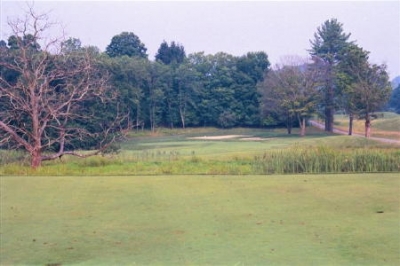 |
| The 455 yard 17th hole features a considerable carry over a marsh to reach the green. The controversial tree is on the left in this photo. |
Randy Hernly tells the story: "Stonewall Jackson Lake State Park, the hunting area and lake were built back in the 80's. The lake and park were built by the Army Corps of Engineers as a flood control measure to manage the flow of the West Fork River. There're about 2000 acres in the state park, and another 18,000 acres in a federal hunting reserve across the lake from us. The State of West Virginia was also involved, and hired McCabe, Henley & Durbin out of Charleston, West Virginia, to develop the property as a Resort. There were also private bonds sold to investors."
Hernly continues, "Stonewall Resort was one of the first of its kind in the country, because it combines federal, state and private interests together -- the Army Corps of Engineers, the State of West Virginia's Department of Natural Resources and these private investors into one ownership interest."
"Benchmark Hospitality was hired to manage the resort and the golf course, and overall, the project has really prospered," Hernly commented.
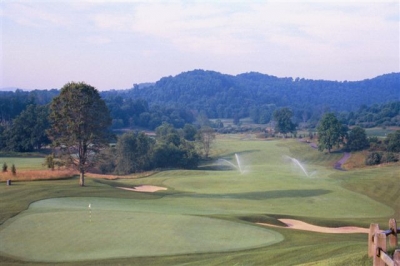 |
| A morning shadow crosses the 18th fairway. From this vantage point, you'll see a lot of the scenic qualities Stonewall Resort has to offer. |
The property is rich in natural beauty, as you'd expect. Stonewall's motto is 'Close to Nature, Far From Ordinary,' and that's pretty accurate. Just a small sampling of what's found at the resort -- the 2,000 acre Stonewall Jackson Lake State Park, 201 guestrooms and suites, 22,000 square feet of conference space, a full service spa, indoor/outdoor pool, restaurant and lodge.
There are also ten lakeside cottages of various sizes, perfect for a family vacation retreat.
Recreational activities are the name of the game here, including the lake with 82 miles of shoreline, Houseboat rentals, boat rentals, public boat launch, fishing (guides available), deer and turkey hunting (in the Wilderness Management area, guides available), hiking trails, fitness center, and as mentioned above, a full-service spa.
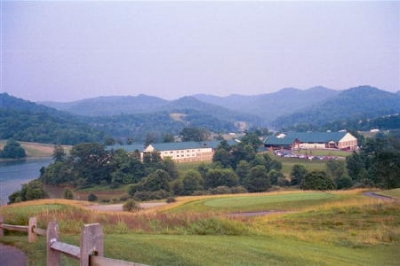 |
| Stonewall Resort's guest accommodations overlook the lake and the golf course. Not a poor view in sight. |
Wine tasting and historical sites are also located nearby. We visited Jackson's Mill Historic Area in Weston, about a 20 minute drive from Stonewall Resort. Civil War buffs will particularly appreciate this brief glimpse into the general's boyhood days, and the park provides a nice outing for an afternoon.
You also need not worry about going hungry or thirsty at Stonewall Resort. Stillwaters Restaurant and T.J. Muskies Lounge are located onsite, serving a nice variety of delights. Stillwaters offers regional cuisine with a southern twist, while T.J. Muskies offers a relaxing atmosphere -- a granite topped bar and a dry-stacked stone wall behind it -- great to unwind at the end of the day.
Stonewall Resort provides a nice, family friendly getaway for its guests. It's convenient to Charleston, Pittsburgh and Washington, DC, and with the addition of the Palmer championship golf course, certainly has to be counted as a golfing destination to consider when planning your next vacation.
Reservations and information: (304) 269-7400.
Note: Check links below for more stories on West Virginia golf.
Details:
Stonewall Resort
940 Resort Drive
Roanoke, WV 26447
Phone: (304) 269-7400
FAX: (304) 269-4358
Website: www.stonewallresort.com
Course Designer: Arnold Palmer; Project Architect: Erik Larsen
Head Golf Professional: Randy Hernly
Superintendent: Chad Clovis
Stonewall Resort is managed by Benchmark Hospitality
|
Tees |
Yardage/Slope |
Rating |
|
Palmer |
7149/143 |
75.4 |
|
Gold |
6726/141 |
73.2 |
|
Blue |
6227/131 |
70.0 |
|
White |
5821/122; 132 (L) |
68.3; 74.2 (L) |
|
Red |
4921/127 |
69.6 |
Rates:
Check the Stonewall Resort website for rates and packages.
Walking is now permitted
| Related Links | Comments on this article? | |
|
Maryland National Golf Club Hollow Creek Golf Club Rocky Gap Resort PB Dye Golf Club in Ijamsville Whiskey Creek Golf Club |
E-mail Jeff Rendall, Editor: jrendall@golftheunitedstates.com |












